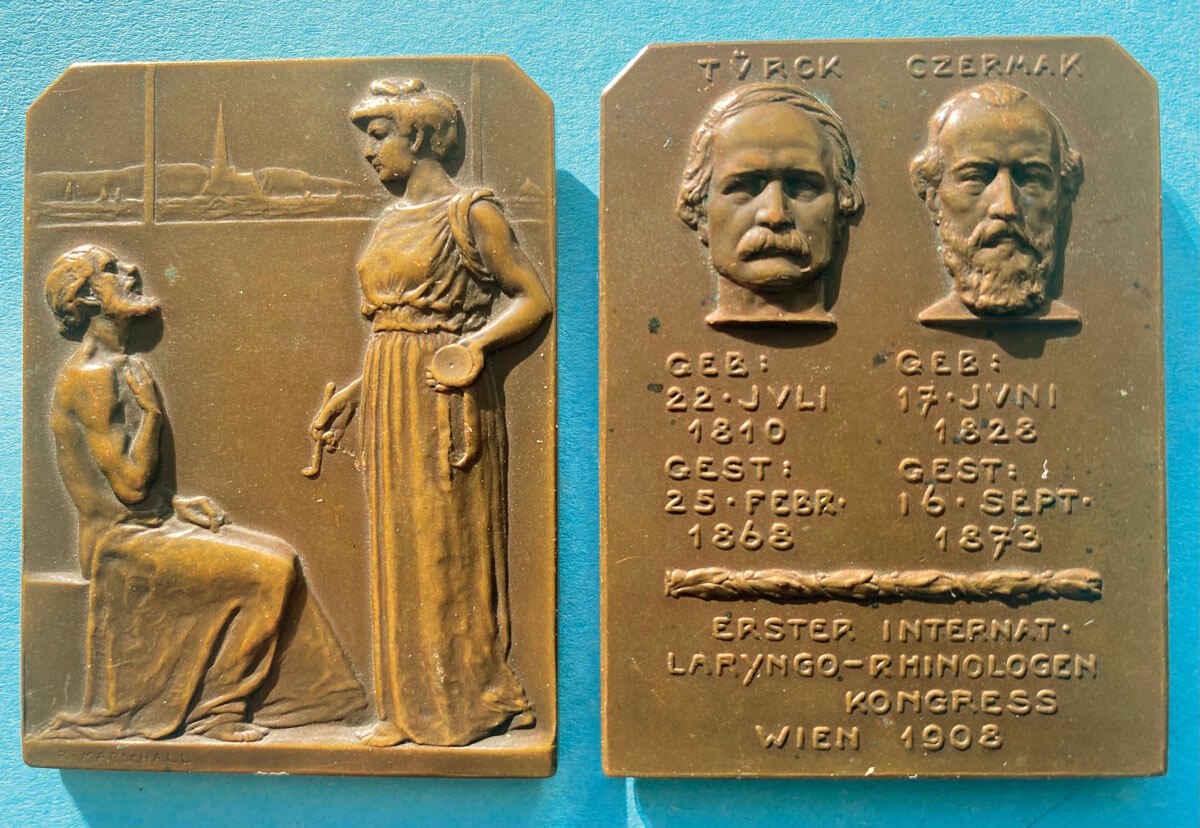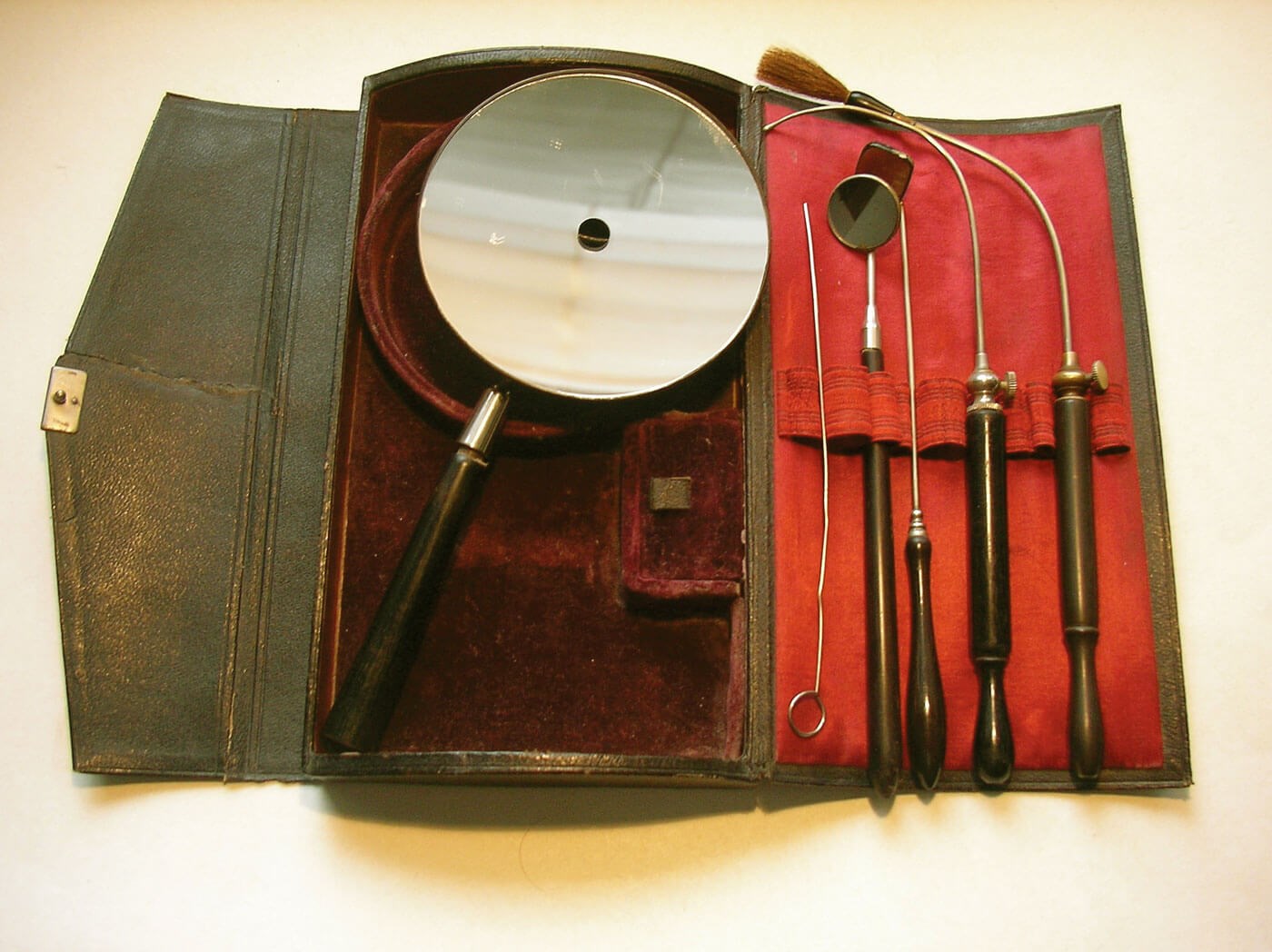“None of today’s young doctors can start to imagine the feeling of professional helplessness and despair that prevailed before the invention of the laryngeal mirror. Thousands of people died, whom we were not able to help, or even bring relief from their suffering! How different things are now! Almost every single branch of medicine has benefitted from the introduction of the laryngeal mirror.”
This quotation comes from a speech by Leopold Ritter Schrötter von Kristelli (1837–1908) at a congress in Vienna in 1908. The meeting was to mark the 50th anniversary of the introduction of laryngoscopy using reflecting mirrors by Ludwig Türck (1810–1868) and Johann N Czermak (1828–1873) in Vienna in 1858. This was the first ever International Congress in Laryngo-rhinology as such.
The Austrian medallist, Professor Rudolf Ferdinand Marschall (1873–1967) created a commemorative plaque for the congress participants. It shows a sitting bearded man, wearing only a loincloth, pointing to his larynx with his right hand. Before him stands a ‘female doctor’ – obviously a stylised representation of a mythical Viennese Hygeia – in a classical stola, holding a laryngeal mirror in her right hand and a traditional head mirror in her left. In the background there is an outline of Vienna’s skyline showing St Stephen’s Cathedral (Figure 1).

Figure 1: Commemorative bronze plaque for first ever International Congress
in Rhino-Larygology, held in Vienna, 1908. ©Wolf Lübbers, Hannover.
The reverse shows a full-face bas-relief of Türck and Czermak (with their dates).
It had taken 50 years after the introduction of indirect laryngoscopy before these two former rivals were depicted together on a medal.
The bitter dispute between them as to which specialist had discovered indirect laryngoscopy in 1858 became known as the ‘Turkish war.
’Türck claimed that Czermak had stolen his invention, which he had already presented extensively in the literature, while Czermak countered that, “Mr Türck just always came too late.” In reality, neither was the inventor. As early as 1837, the Scottish surgeon Robert Liston claimed to have examined the larynx using a dental mirror; and in 1855, the singing teacher Manuel Garcia (1805–1906) had recommended indirect laryngoscopy with small mirrors.
Later generations of laryngologists have credited Türck as the founder of laryngoscopy with sunlight, and Czermak as the inventor of the use of artificial light in laryngoscopy.
They both, however, helped laryngology achieve its breakthrough. Czermak was active in lecturing and with respect to their publications, Czermak’s was a few days before Türck’s.
Notwithstanding their rivalry, the laryngeal mirrors specified by Türck were round or oval, while those by Czermak were square with rounded edges. They also had a different angle between the mirror and the holder handle.

Figure 2: Leather-cased laryngology set (circa 1900) including squirrel
hairbrush for brushing tonsils. ©Wolf Lübbers, Hannover.
Around 1900 complete cased laryngology sets became available (Figure 2). In addition to the head mirror, they included a range of different sized laryngeal mirrors, a laryngeal probe and a brush attachment made from squirrel or camel hair for the contemporary practice of ‘throat brushing.’
Nowadays, only a very few of our junior colleagues have any skill in using a head mirror and resort immediately to fibreoptic devices.
The burning question of course, is what will be considered modern in 50 years’ time?




